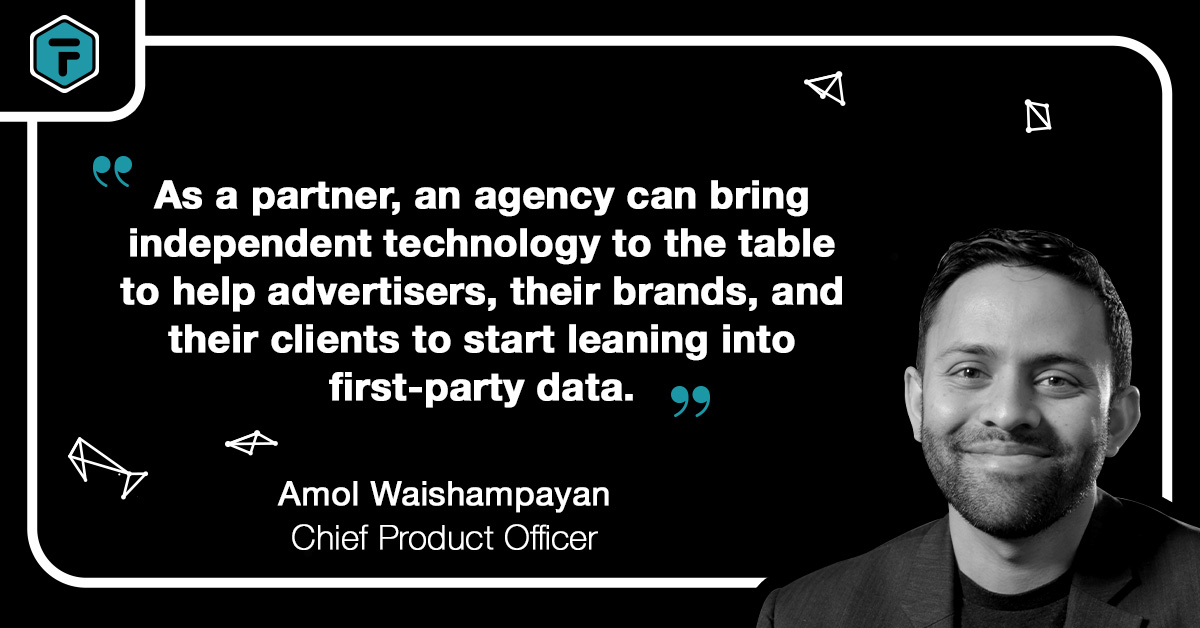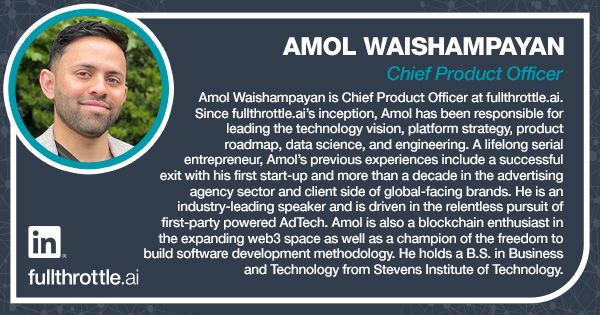
How Agencies Can Walk the Walk
by Amol Waishampayan, CPO
The AdTech agency, media, and brand world talk a lot about first-party data. It is the way forward and everyone is going to be leaning into it. However, for the most part as an industry, we’ve only seen articles on utilizing first-party data. Not many businesses have taken steps towards creating and leveraging first-party data, such as using, buying, investing, or changing a process/tool/technology.
Everyone talks the talk, but no one walks the walk.
If you are one of these organizations trying to use first-party data, where do you start? How can agencies start to walk the walk?
Who Do You Go To?
The places that have the most accessible media today are probably not the same places that are going to get you first-party data, like Facebook, Google, or third-party data asset companies.
They are not going to help you create your own first-party data. They’re in the business of creating their own data to rent to you. Sure, you can activate their audiences; however, at the end of the day, it’s still their first-party data.
These companies have so much of the audience and media wallet share in the industry that most organizations are going to them first to see how they can help their business.
The problem with that is there is essentially a conflict of interest. You’re going to someone who’s in the business of renting data and asking to buy—but they’re in the renting business.
If this is how your agency is approaching data, then the first step for you would be to look elsewhere from where you’ve always been looking. Think differently.
Where Do You Begin?
It’s simple—start with your clients’ site traffic. It’s the most untapped resource.
The second step to walking the walk is evaluating where your clients may have a first-party data opportunity. Lululemon is a great example of outside-the-box data. They host yoga classes in store, which is specific data when those customers sign up. They also collect massive data from all their e-commerce shoppers.
Agencies need to look at all the different touchpoints.
For a lot of businesses, whether you’re retail or e-commerce, it's hard to find sources where you have true first-party data.
Sometimes there are loyalty or rewards programs where someone has signed up—that’s first party data. Not everyone has that, especially if you’re not working with a huge national brand. They may have some leads off a promotion.
All businesses have information from people who have previously purchased. However, that’s a small percentage of the first-party data your agency could be utilizing and is only looking at the past. What if you had a way to look at future purchases?
The next biggest way to find/collect first-party data is that the brands you work with might have a lot of traffic on your site. That’s typically a great place to start, as there’s so much data dying on the vine. It’s not getting picked up and it’s going unused. You have all this traffic you wouldn’t know about, which is unused data.
How To Use Your Website if You Feel Your Traffic Is Low
Even if you work with a Consumer Packaged Goods (CPG) company—meaning that they sell their products in someone else’s store—you should still be utilizing website traffic.
You might be wondering who goes to these brands' websites. Truthfully, not many do. For example, let’s say you work with a juice company that sells their juice products in grocery stores across the country. Typically, not many shoppers go directly to the juice company’s website.
That being said, a lot of those CPG brands’ sites still receive website traffic and could drive more. You might be surprised at the volume of traffic they actually receive. 75% of shoppers looking for consumer packaged goods will conduct an online search prior to purchasing. Not to mention the traffic CPG brands are driving to their website when they run sweepstakes, offer rebates, or even have recipes for their product on their website.
All of this traffic is first-party data, which is why the website is still the best place for an agency to start.
What CPG companies and their agencies should be thinking about is running promotional and digital experiences to bring consumers back onto owned sites, where they can essentially create more data on the vine. This is a key place to start the path to creating first-party data.
Experiences hosted with third-party data sites, like Hulu, is very valuable. When companies run interactive ads on Hulu, this is a great way to create an audience that is engaged and actively working with the ad.
The more that brands can bring interactivity into owned experiences that are not limited to third-party platforms like Hulu, then they can start to take advantage of the audiences being created within those interactive ads. Otherwise, it’s just Hulu reaping the rewards. This is the same with using TikTok, Instagram, YouTube, or any other social media platforms.
A great example of a CPG company running successful campaigns and driving traffic to their owned microsites is Red Bull. They run a ton of great videos and digital experiences, with good promotional sites and huge campaigns. They also run TV commercials, which drive viewers to their promotional microsites.
CPG companies and their agencies should be thinking about these assets as places they can cultivate and grow first-party data.
Agencies Can Provide More Than Services to Their Brands
Agencies are used to providing services to their brands. They have grown up with a very service-oriented mission, such as providing media, creative, and/or marketing services to their clients. Unless they’re specifically a technology agency, they typically aren’t providing platforms to their clients.
However, in order to be more competitive and grow in today’s climate, they also need to provide technology––and not just technology, but a technology partner. As a partner, an agency can bring independent technology to the table to help advertisers, their brands, and their clients to start leaning into first-party data.
Agencies who do that will be rewarded and recognized in the coming years. Instead of keeping their clients hooked on the third-party data companies and walled gardens, they’re actually walking the walk and taking a step forward in helping their clients start their journey to data independence.
FullThrottle Helps Agencies Walk the Walk
FullThrottle aids agencies and their clients with modern technology made to identify website traffic. Our technology has shown incredible results for agencies and their clients, who often don’t realize how much website traffic they really have. On top of that, FullThrottle’s technology can instantly market to these website visitors in a cookieless, privacy-first manner.
To discover how FullThrottle can help your agency and clients, schedule a demo today.




